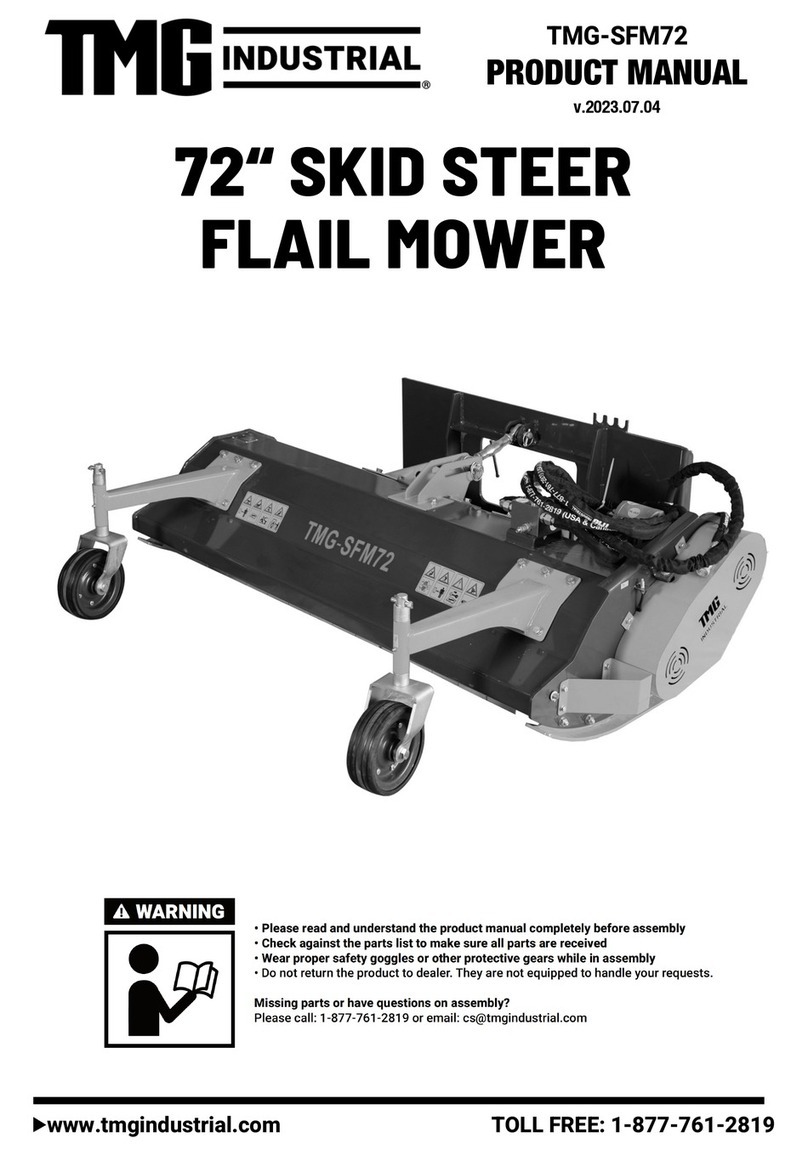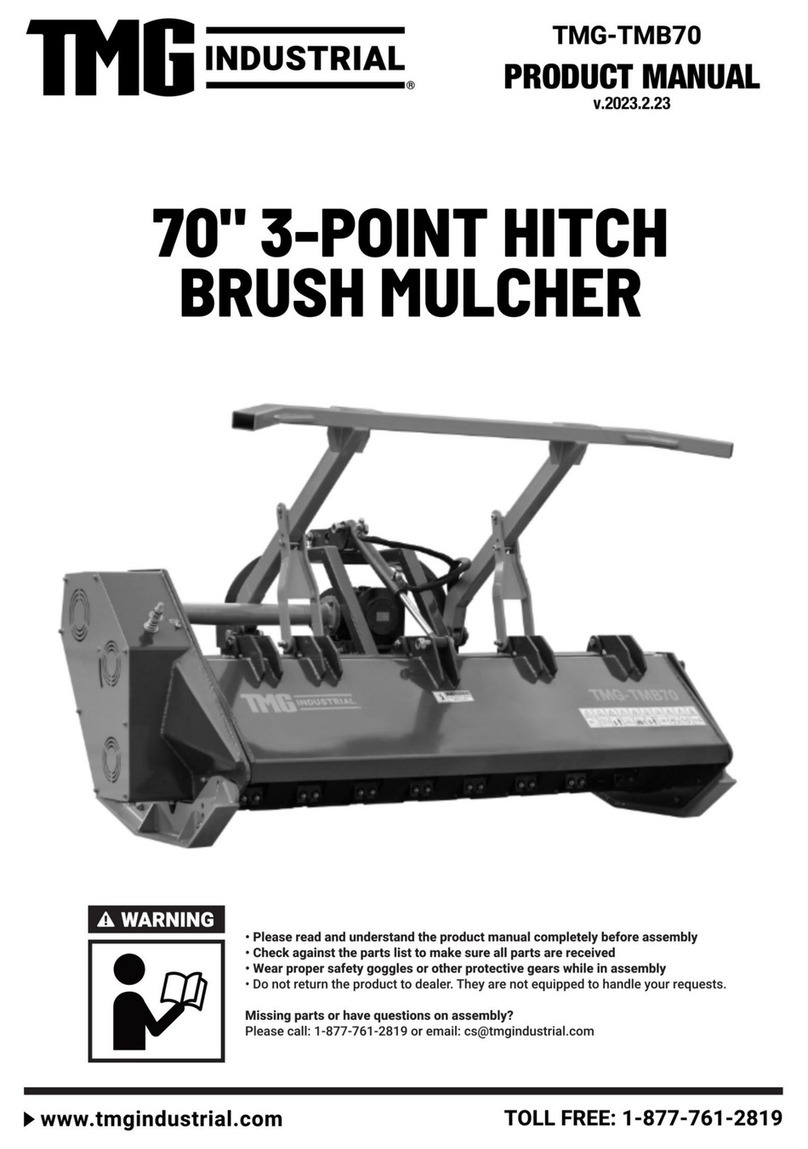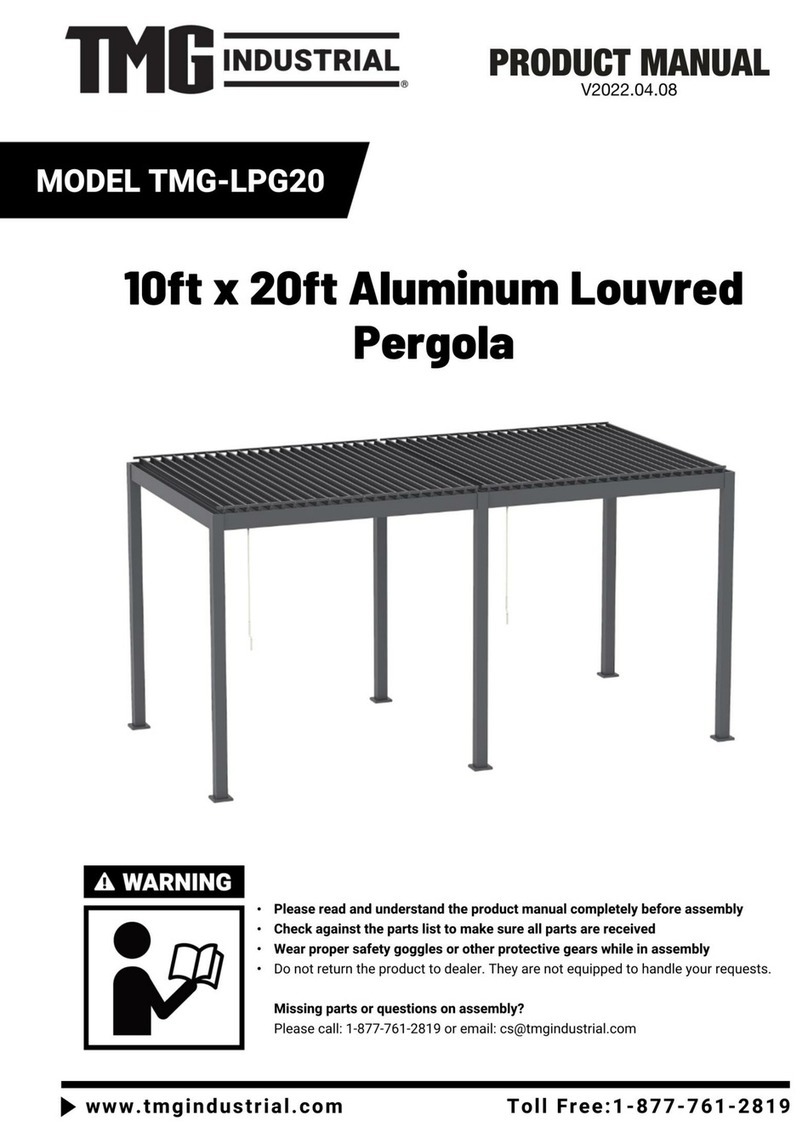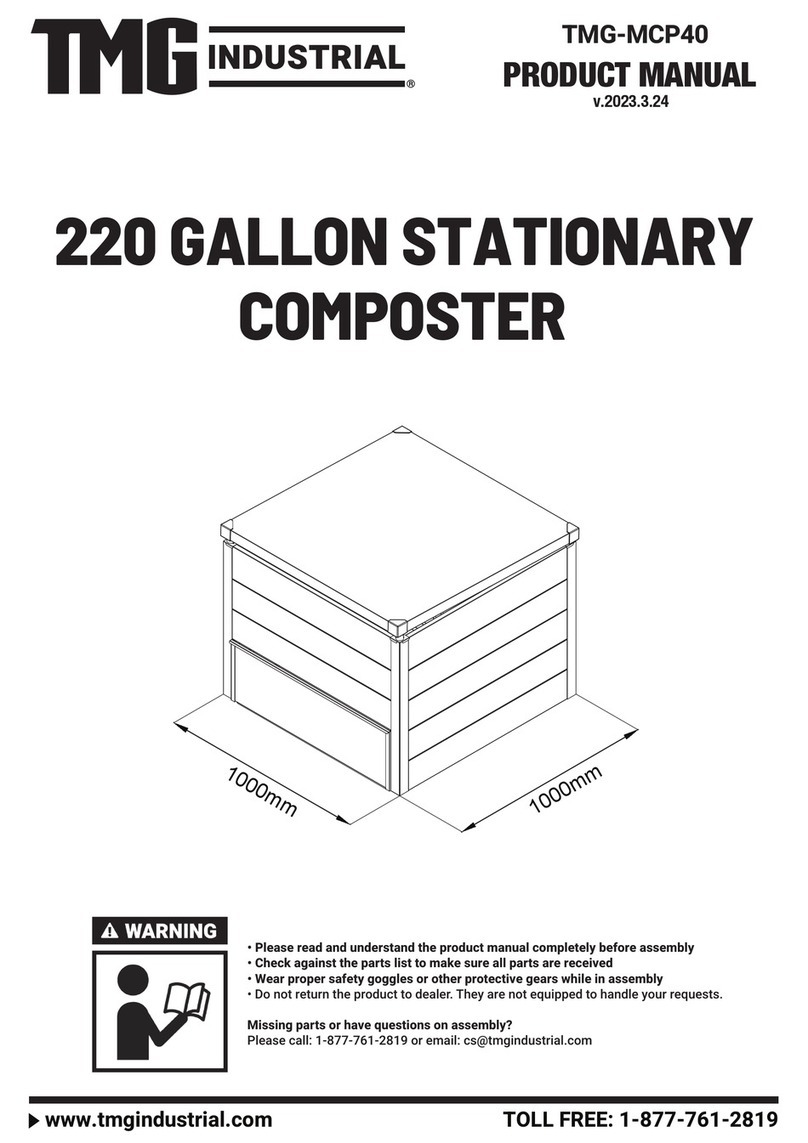TMG TMG-TMB55 User manual

►
www.tmgindustrial.com 0/18 TOLL FREE:1-877-761-2819
1. SAFTY.................................................................................................................................................................. 2

►
www.tmgindustrial.com 1/18 TOLL FREE:1-877-761-2819
1.1 General................................................................................................................................................................. 2
1.2 Safety Instructions................................................................................................................................................ 2
1.3 TMG Brush Mulch er –Description and Applications............................................................................................ 3
1.4 Operational Safety The Work Area......................................................................................................................... 4
1.5 The Hazard Zone................................................................................................................................................... 4
1.6 Dangerous Locations............................................................................................................................................ 5
1.7 Urban Precautions.................................................................................................................................................. 6
2. OPERATIONAL SAFETY/ THE OPERATOR............................................................................................................... 6
2.1 Sound Levels/ Hearing Protection.................................................................................................................. 6
2.2 Dust Protection...................................................................................................................................................... 7
2.3 Protection from Flying or Falling Objects................................................................................................................7
2.4 Avoid Power Lines..................................................................................................................................................7
2.5 Operator Protection................................................................................................................................................ 7
2.6 Stopping the Rotor Before Exiting the Carrier........................................................................................................ 9
3. CARRIER VEHICLE PREPARATION/MAINTENANCE................................................................................................. 9
3.1 Shielding................................................................................................................................................................. 9
3.2 Carrier Vehicle Preparation/Maintenance............................................................................................................ 10
3.3 Carrier Clean-up................................................................................................................................................... 10
4. POLICING THE WORK AREA................................................................................................................................. 11
4.1 Avoid Metal and Wire........................................................................................................................................... 11
4.2 Use Caution with Stringy Vegetation.....................................................................................................................11
4.3 Avoid Plastics....................................................................................................................................................... 11
4.4 Depth Shoe Adjustment...................................................................................................................................... 11
5. MULCHER OPERATION......................................................................................................................................... 12
5.1 Push working........................................................................................................................................................ 12
5.3 Stump Grinding................................................................................................................................................... 19
5.4 Finishing the Work................................................................................................................................................ 20
5.5 Hydraulic Push Bar Operation (Optional Equipment)........................................................................................... 20
5.6 Trap Door............................................................................................................................................................. 21
6. PREVENTATIVE MAINTENANCE........................................................................................................................... 22
6.1 SAFETY FIRST...................................................................................................................................................... 22
6.2 Rotor Power Belts................................................................................................................................................. 22
6.3 Lubrication Points............................................................................................................................................... 26
6.4 Tighten All Bolts................................................................................................................................................... 27
7. ROTOR MAINTENANCE........................................................................................................................................ 27
7.1 Visual Inspection.................................................................................................................................................. 27
7.2 Tool Replacement................................................................................................................................................ 28
8. DISPOSAL PROCEDURE........................................................................................................................................ 28
9. PART LIST........................................................................................................................................................... 28
WARNING

►
www.tmgindustrial.com 2/18 TOLL FREE:1-877-761-2819
1. Read manual before operating .
2. Do not operate or perform maintenance on your brush mulcher without reading and understanding this entire manual
first.
3. If this manual is lost or if you have any questions, contact TMG or your dealer before you proceed.
UNDERSTAND THE WRITTEN INSTRUCTIONS, RULES AND SAFETY PRECAUTIONS
1. The written instructions rules and safety precautions are outlined in this operation and safety manual.
2. Check the rules and regulations at your location. The rules include employer’s work safety regulations and local
government guidelines’ and restrictions for safe operation of the equipment.
PERFORM APPLICATION TRAINING WITH OPERATOR
1. Conduct felid instruction with a trained Operator. Application training should include complete vehicle safety,
operation training, complete mulching safety and application training.
2. Know and understand your work conditions; hazards should be reviewed and terrain surveyed at this time as well as
with all new work sites.
3. Verify that the machine is in complete safe working order and prepared for your application.
1. SAFETY
1.1 GENERAL
The forestry mulcher is designed to process heavy organic material such as branches, stumps, heavy timber and brush.
1.2 SAFETY INSTRUCTIONS
SAFETY ALERT SYMBOL
This symbol is used throughout this manual to call attention to safety procedures.
DANGER
The word DANGER indicates an immediate hazardous situation, which if not avoided, will result in death or serious injury.
WARNING
The word WARNING indicates a potentially hazardous situation which, if not avoided, could result in death or serious
injury.
CAUTION
The word CAUTION preceded with a safety alert symbol indicates a potentially hazardous situation which, if not avoided,
may result in minor or moderate injury
NOTICE
Indicates information or a company policy that relates directly or indirectly to the safety off personnel or protection of
property.
SAFETY FIRST
With any piece of equipment, new or used, the most important part of its operation is safety! We encourages you and
your employees to familiarize yourselves with your new equipment and to stress safe operation!!
PRIOR TO OPERATION:
Read the owner’s manual in its entirety and follow all safety procedures.
Check all grease points per the owner’s manual.
Inspect all fasteners for tightness with power off.

►
www.tmgindustrial.com 3/18 TOLL FREE:1-877-761-2819
Inspect all fasteners for tightness with power off.
Manually turn rotor to inspect tool bolts with engine off.
Check gearbox oil (PTO models) for proper level per owner is manual.
Obey all safety labels on the forestry mulcher. They are provided for your protection. If any labels are removed, damaged,
or made unreadable in any way, call your dealer for a replacement.
1.3 TMG BRUSH MULCHER –DESCRIPTION AND APPLICATIONS
Forestry
Orchard Removal
Land Clearing
Transfer Stations
Stump Grinding
ROW Maintenance
Yard Waste Process
Forest Fire Prevention
Brush and Slash Piles
The versatile forestry mulcher was designed for shredding woody materials. The forestry mulcher excels at processing
yard waste, land preparation and slash reduction. It has multiple uses for farmers, parks, golf courses, loggers, land
clearing companies, ranchers, foresters and silvaculturists.
The mulcher fixed tools are designed to withstand daily brush shredding, land clearing and stump grinding operations.
The forestry mulch shreds material into a fine particle size by going over the shredded material until the desired texture
is achieved.
If left on the ground the shredded material is beneficial to the soil. On steep slopes the output from the mulcher is ideal
for interim erosion control.
1.4 OPERATIONAL SAFETY THE WORK AREA:
For the sake of this manual, the front of the mulcher is the side with the rotor exposed. The rear has defection chains. For
crawlers and rubber tire machines, when the mulcher is mounted on the front of the machine, the front of the mulcher is
facing the same forward direction. If mounted on the rear, the front of the mulcher is facing away from the rear of the
carrier. Mounting for excavators and other boom-type installations may vary but references to the front and rear of the
mulcher remain the same.
1.5 THE HAZARD ZONE
Flying debris or objects and falling objects can cause serious injury or death Improper operation and failure to follow
safety precautions can cause serious injury or death. All personnel must be clear of the hazard zone while the mulcher is
in operation.
The Hazard Zone is illustrated in Figure 1.1 on the following page. All personnel should be kept clear of this zone while
the mulcher is operating.
The shaded area in the hazard zone must be considered off limits to all individuals! The operator should follow the
precautions below before and during operation of the mulcher.
HAZARD ZONE PRECAUTIONS
It is the operators responsibility to ensure that no one enters the hazard zone!Warn all persons in the area of the hazard
zone.
Stay alert for outsiders entering the work area who may not be aware of thehazard zone.
Land clearing operations generally involve other machinery and people on the site.
Maintain an awareness of all working traff c within 150 ft (45 m) (to each Side) and 300 ft (90 m) (in front and behind) of
the mulcher operation.

►
www.tmgindustrial.com 4/18 TOLL FREE:1-877-761-2819
1.6 DANGEROUS LOCATIONS
Flying debris or objects and falling objects can cause serious injury or death
Improper operation and failure to follow safety precautions can cause serious injury or death. All personnel must be clear
of the hazard zone while the Mulcher is in operation.
DANGER EXISTS MOST PROMINENTLY IN FRONT OF AND BEHIND THE MULCHER.
Pieces of wood and rock can project from the mulcher. This condition is dangerous. This will occur when the mulcher is
raised high enough to allow material to escape.
FOLLOW THESE PRECAUTIONS:
1. NEVER allow anyone to enter the Safety Zone of the mulche while it is in operation.
2. INSPECT the Carrier and mulcher daily for damaged or missing defection chains and flaps.
Be especially careful when:
When the mulcher is being raised up and out of the material that it is working in.
When the mulcher is lowered into new material.
CLOSE the hydraulic trap door (if equipped) while pull-working to better contain material. This also increases the
fineness of the shredded product.
(See section 5.2, Mulcher Operation –Pull-working).
1.7 URBAN PRECAUTIONS
A step-up of safety procedures and precautions is required when working:
Near streets
Near highways
In parks, on golf courses or other inhabited areas
Near buildings
Table of contents
Other TMG Lawn And Garden Equipment manuals
Popular Lawn And Garden Equipment manuals by other brands

Sunforce
Sunforce SOLAR user manual

GARDEN OF EDEN
GARDEN OF EDEN 55627 user manual

Goizper Group
Goizper Group MATABI POLMINOR instruction manual

Rain Bird
Rain Bird 11000 Series Operation & maintenance manual

Cub Cadet
Cub Cadet BB 230 brochure

EXTOL PREMIUM
EXTOL PREMIUM 8891590 Translation of the original user manual

Vertex
Vertex 1/3 HP Maintenance instructions

GHE
GHE AeroFlo 80 manual

Land Pride
Land Pride Post Hole Diggers HD25 Operator's manual

Yazoo/Kees
Yazoo/Kees Z9 Commercial Collection System Z9A Operator's & parts manual

Premier designs
Premier designs WindGarden 26829 Assembly instructions

Snapper
Snapper 1691351 installation instructions










